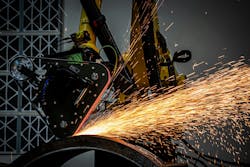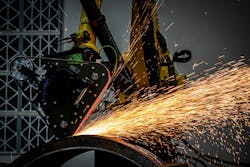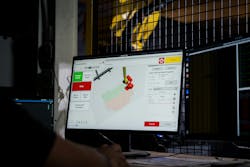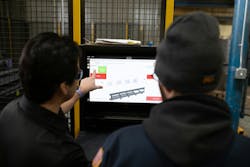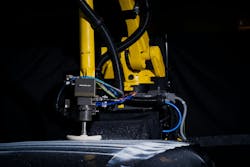Physics-Informed AI and Digital Twins: Engineering the Next Generation of Autonomous Manufacturing Systems
What You’ll Learn:
- When physics-informed AI leverages physical laws and material science principles directly into their neural network architectures, it compensates for the scarcity of failure data and edge cases in manufacturing automation and robotics systems, where it would be prohibitively expensive to collect at scale.
- An overview of the data streams derived from sensor architecture that enables bidirectional communication between digital twins and physical systems.
- A case study based on an aerospace manufacturer implementing digital twin technology for turbine blade finishing.
The convergence of physics-informed artificial intelligence (AI) and digital twin technology is fundamentally transforming how robotic systems operate in manufacturing environments. Unlike traditional automation that relies on pre-programmed sequences, these intelligent systems create dynamic, bidirectional relationships between physical processes and their digital counterparts, enabling unprecedented levels of autonomy and adaptability.
The Engineering Foundation: How Physics-Informed AI Works
Physics-informed AI represents a paradigm shift from purely data-driven machine learning approaches. Instead of requiring massive datasets to learn patterns, these systems incorporate established physical laws and material science principles directly into their neural network architectures. This approach addresses a critical limitation in manufacturing: the scarcity of failure data and edge cases that would be prohibitively expensive to collect at scale.
In robotic surface finishing applications (Fig. 1), for example, the AI system embeds fundamental equations governing material removal rates, tool wear mechanics and force dynamics. When a robot encounters a new material or geometry, it doesn’t start from scratch—it leverages physics constraints to predict optimal process parameters. The system then uses real sensor data to refine these predictions, creating a hybrid model that combines known models with empirical data.
The mathematical foundation involves partial differential equations that describe heat transfer, stress distribution and material deformation. These equations inform the neural network’s loss function, ensuring that predictions remain physically plausible even when extrapolating beyond training data. This physics-informed approach dramatically reduces the time and data required for deployment while maintaining safety and reliability.
Sensor Networks and Real-time Data Integration
The bidirectional communication between digital twins (Fig. 2) and physical systems relies on sophisticated sensor architectures that capture multiple data streams simultaneously. In advanced manufacturing cells, this typically includes:
Force and torque sensing. Six-axis force/torque sensors mounted at robot end-effectors provide real-time feedback on contact forces, enabling dynamic adjustment of process parameters. These sensors operate at kilohertz frequencies, capturing variations that indicate tool wear, material inconsistencies or collision risks.
READ MORE: Generative AI Catalyzes Growth in Industrial Robotics & CNC Machining
Vision systems. Structured-light 3D scanners and high-resolution cameras create detailed geometric models of workpieces. Advanced systems use hyperspectral imaging to identify material composition and surface defects that aren’t visible to conventional cameras. Machine learning algorithms process this visual data to detect anomalies and guide robotic motion planning.
Acoustic monitoring. Microphones and accelerometers detect vibration signatures that indicate tool condition, material properties and process quality. Frequency domain analysis reveals harmonics associated with specific failure modes, enabling predictive maintenance strategies.
Environmental sensors. Temperature, humidity and air quality monitors ensure process consistency and worker safety. These sensors also feed into digital twin models that account for environmental effects on material behavior and process outcomes.
The IoT connectivity infrastructure ensures low-latency communication. Edge computing nodes process sensor data locally, reducing bandwidth requirements and enabling real-time decision-making with fast response times.
Digital Twin Architecture for Manufacturing Systems
A manufacturing digital twin operates as a multi-layered system that mirrors physical processes at different levels of abstraction. The architecture typically includes:
Component-level models. Individual system components—robots, tools, sensors—have dedicated digital representations that track their state, performance and health. These models can use finite element analysis to predict component behavior under various operating conditions.
Process-level integration. Higher-level models simulate entire manufacturing processes, incorporating interactions between multiple components. These models account for material flow and quality propagation through production stages.
System-level optimization. Enterprise-level digital twins optimize production schedules, resource allocation and maintenance strategies across multiple manufacturing cells. Machine learning algorithms analyze historical performance data to identify bottlenecks and recommend process improvements.
The digital twin continuously updates its models using incoming sensor data through appropriate filtering techniques (e.g., Kalman filtering and particle filtering). These probabilistic methods account for sensor noise and uncertainty while maintaining accurate state estimates.
Uncertainty Quantification in Real-World Applications
Manufacturing environments present numerous sources of uncertainty (Fig. 3) that traditional automation systems struggle to handle. Digital twins address this challenge through rigorous uncertainty quantification methods that provide confidence bounds on predictions and recommendations.
Part variability. Even nominally identical parts exhibit variations in material properties, geometry and surface conditions. The digital twin uses statistical models to characterize these variations and their impact on process outcomes. Monte Carlo simulations explore the range of possible scenarios, enabling robust process planning that accounts for expected variations.
READ MORE: Q&A: Integrating Physical AI with Physics and Mechanics of Industrial Machines
Sensor uncertainty. All measurements contain noise and systematic errors that propagate through the system. The digital twin employs sensor fusion techniques that combine multiple data sources to reduce overall uncertainty.
Model uncertainty. Physics models and machine learning algorithms have inherent limitations and assumptions. The digital twin quantifies model uncertainty using empirical data.
Case Study: Advanced Surface Finishing in Aerospace Manufacturing
Consider an aerospace manufacturer implementing digital twin technology for turbine blade finishing. Traditional approaches require extensive fixturing and programming for each blade geometry, limiting flexibility and increasing costs. The physics-informed digital twin system transforms this process through several key innovations:
Adaptive process planning. The system scans each blade using structured-light 3D imaging, creating a detailed geometric model. Physics-informed algorithms generate optimal tool paths that account for material removal rates, surface roughness requirements and geometric constraints (Fig. 4). The system automatically adjusts for part-to-part variations without requiring manual programming.
Real-time process monitoring. Force sensors detect variations in cutting conditions that indicate tool wear or material inconsistencies. The digital twin correlates these force signatures with material removal models to predict surface quality and adjust process parameters dynamically.
Predictive quality control. Machine learning models trained on historical data predict final surface quality based on in-process measurements. This enables early detection of quality issues and automatic process parameter adjustments before defects occur.
Autonomous tool management. The digital twin monitors tool condition using multiple sensor modalities and physics-based wear models. It predicts optimal tool change intervals based on part requirements and process conditions, minimizing tool costs while maintaining quality standards.
Future Directions: Agentic AI and Autonomous Manufacturing
The next evolution in manufacturing digital twins involves agentic AI systems that can reason about complex scenarios and make autonomous decisions. These systems combine many different AI approaches to enable complex problem-solving.
Multi-agent coordination. Future manufacturing systems will deploy multiple AI agents that collaborate to optimize production outcomes. Each agent specializes in specific aspects—process planning, quality control, maintenance scheduling—while communicating through standardized interfaces. This distributed approach enables scalable automation that adapts to changing production requirements.
READ MORE: Safe Zone: AI-Powered Platform Keeps Industrial Workspaces Safer
Causal reasoning. Advanced AI systems will incorporate causal inference methods that go beyond correlation to understand cause-and-effect relationships in manufacturing processes. This capability enables a better generalization of novel scenarios.
Human-AI collaboration. Digital twins will serve as intelligent assistants that augment human expertise rather than replacing it. Natural language interfaces will allow operators to query system state, explore “what-if” scenarios and receive actionable recommendations.
Implementation Considerations and Best Practices
Successful deployment of physics-informed digital twins requires careful attention to several engineering considerations:
Data infrastructure. Robust data collection and storage systems must handle high-frequency sensor streams while maintaining data integrity and security. Time-series databases optimized for industrial applications provide the performance and reliability required for real-time operations.
Model validation. Physics-informed models require extensive validation against experimental data to ensure accuracy and reliability. Systematic testing protocols should verify model performance across the full range of operating conditions and material properties.
Cybersecurity. Connected manufacturing systems present new attack vectors that must be addressed through comprehensive security frameworks. Encryption, authentication and network segmentation protect sensitive data and prevent unauthorized access to critical systems.
Change management. Organizations must develop new skills and processes to effectively utilize digital twin technology. Training programs should cover both technical aspects and operational procedures to ensure successful adoption.
The integration of physics-informed AI and digital twins represents a fundamental shift toward autonomous, adaptive manufacturing systems. By grounding artificial intelligence in established physical principles while leveraging real-time sensor data, these technologies enable unprecedented levels of flexibility, quality and efficiency in manufacturing operations. As these systems continue to mature, they will unlock new possibilities for mass customization, sustainable production and improved quality.
About the Author
SK Gupta
Chief Scientist and co-founder, GrayMatter Robotics
SK Gupta is chief scientist and co-founder at GrayMatter Robotics, where he leads the development of AI technologies for autonomous manufacturing solutions.
